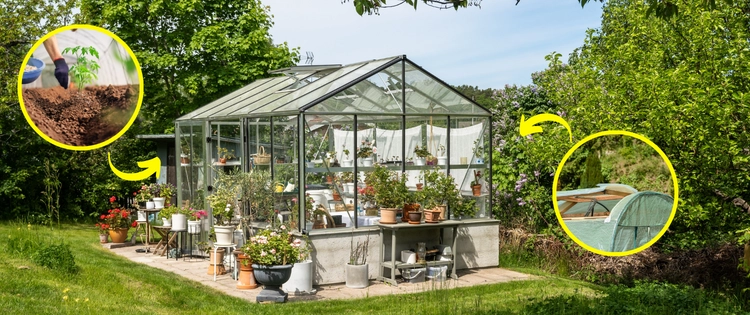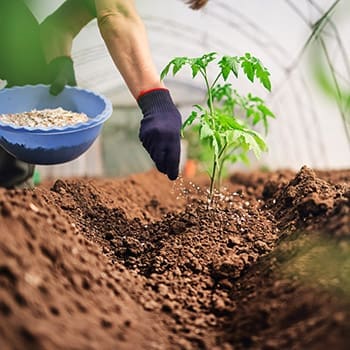There are several common mistakes people make when they first start greenhouse gardening. Many of our mistakes encourage plant diseases to thrive in the warmth and humidity of the greenhouse, while others lead to poor plant growth. Let’s look at these seven mistakes and how to avoid them so you can have healthy greenhouse plants!
1. Poor Ventilation
Proper air circulation is critical in all greenhouses, regardless of your environment. We often build greenhouses without considering good ventilation because they are designed to protect plants from the elements, so why would you invite the elements in?
Proper ventilation is important in spring as plants grow and the greenhouse heats up. The lack of ventilation at this time creates the perfect conditions for diseases to thrive. Later, in the summer, ventilation is critical to prevent your greenhouse from getting too hot and stressing your plants, or worse.
Plan ventilation systems when designing your greenhouse by adding roof vents, exhaust fans, or louvered windows that can be opened to allow airflow. If your greenhouse is already built, simple oscillating fans and leaving the door open will help until you can install an exhaust fan or roof vents.
2. Watering Incorrectly
People often water incorrectly, either watering too much or too little. We may not realize how fast greenhouse plants dry out compared to those in the ground. Even if your greenhouse plants are in beds rather than pots, the greenhouse is hotter than outside and it will dry out faster.
Alternatively, some people are too attentive to their plants and overwater them. This can lead to the growth and spread of plant diseases.
The best solution is to check your soil before watering. Put your finger about an inch (2.5cm) into the soil and feel it. If it’s dry, water it, but water deeply. Don’t just mist the surface; that’s not good for root development. If your soil is still moist, wait another day or two. If it’s still wet, you were probably overwatering, or you have a drainage issue. As you learn about your greenhouse, you will learn when it should be watered.
Related: 5 Ingenious Methods To Get FREE WATER In All 50 States During A Crisis
3. Soil Health
Nutrient-rich soil is essential for healthy plants but is often overlooked. You should either improve your soil yearly or change it out completely about every two years.
Improving the soil is what organic gardeners do naturally. But even if you use synthetic fertilizers, you should still improve the soil. Fortunately, it’s easy to do; just add organic matter. This can be aged garden compost, composted manure or fine bark, or using worm castings. These will create a healthy soil profile, add nutrients, retain water better while reducing water stress, and reduce your dependence on fertilizer inputs.
If you use pots, repot your perennials every 1-2 years at most, and use fresh soil. The old soil can be repurposed by working it into your compost or garden. In a year when you are not repotting, mulch the surface with compost.
4. Not Enough or Too Much Sunlight
Sometimes, we choose a spot in our yard for our greenhouse because it’s flat, close to a water source, or for other reasons of convenience when we should be picking the location based on the needs of the plants.
Most garden plants require a minimum of six hours of direct sunlight daily. If your yard is naturally shady, orient your greenhouse so that the roof receives the maximum light possible, and consider using full transparent glass on the roof to maximize the light. Another option is to install supplemental LED grow lights. These are great to give your plants the full spectrum light they need when they cannot get enough from their environment.
However, if you live in a very hot climate with lots of sun year-round, you should use opaque polycarbonate roofing to diffuse the intense sunlight so your plants don’t overheat so easily. Depending on your exposure, you may still want to supply LED light so that your plants get enough light in the off-season.
5. Too Much or Too Little Fertilizer
Plants need light + water + nutrients to thrive, so it’s important not to skimp on any of those. Many gardeners understand that but then overfeed their plants. This can lead to weak growth and plants that fall over or are susceptible to diseases. So, ensure you follow the instructions on your fertilizer package carefully. They come in many different strengths and styles, so there is no one-size-fits-all answer to how much and how often you should feed them.
Underfeeding, on the other hand, creates poor growth with low yields. Again, ensure you follow the feeding schedule on your fertilizer.
When you use organic amendments, plants need much less food. However, many people don’t feed them when they use amendments, thinking they are enough. In the garden, it often is. But in the greenhouse with limited soil, it depends on the plants and the season. So, it’s a good idea to still feed them, especially during the spring when they are starting to grow and later as they flower and start producing fruits. You can still use organic fertilizers. Homemade aerated compost, manure, or seaweed teas will instantly boost your plants when needed.
6. Not Mulching
Mulch is one of the most commonly omitted essential factors with some thinking it’s just unnecessary extra work. However, nearly all plants benefit from mulch, especially those in pots and beds. The mulch moderates the soil temperature, keeping the roots cooler in summer and warmer in winter. It reduces evaporation from the soil, reducing water stress and making it so you don’t have to water your plants so often. Mulch also significantly reduces the need for weeding. Mulch not only makes for happier plants but that “unnecessary work” actually makes your job much easier!
Ideally, use a layer of compost mulch to nourish the soil and plants and some leaf or aged bark mulch on top. A really good system uses compost, followed by 2 layers of newspaper that will smother weeds as they try to grow, followed by the leaf or bark mulch on top. Leave mulch on perennials for the winter. The mulch from your annuals can be saved or tossed in the compost at the end of the season.
7. Overcrowding
When we get our greenhouse up and running, trying to fill them with as many plants as possible can be tempting. However, plants need room to grow and spread their roots, branches, and leaves. Overcrowding will limit their access to water, light, and nutrients, and you don’t want your plants competing with each other since this will stress them all.
Overcrowding also restricts the airflow around them, trapping humidity and creating conditions for plant diseases like powdery mildew and others to thrive.
You may also like:
The Backyard Tree Syrup Our Grandparents Used to Make Each Spring (Video)
Strange Ways to Grow Potatoes In a Tiny Space
13 Plants That Thrive In Shade
What Livestock My Grandparents Raised During The Great Depression











